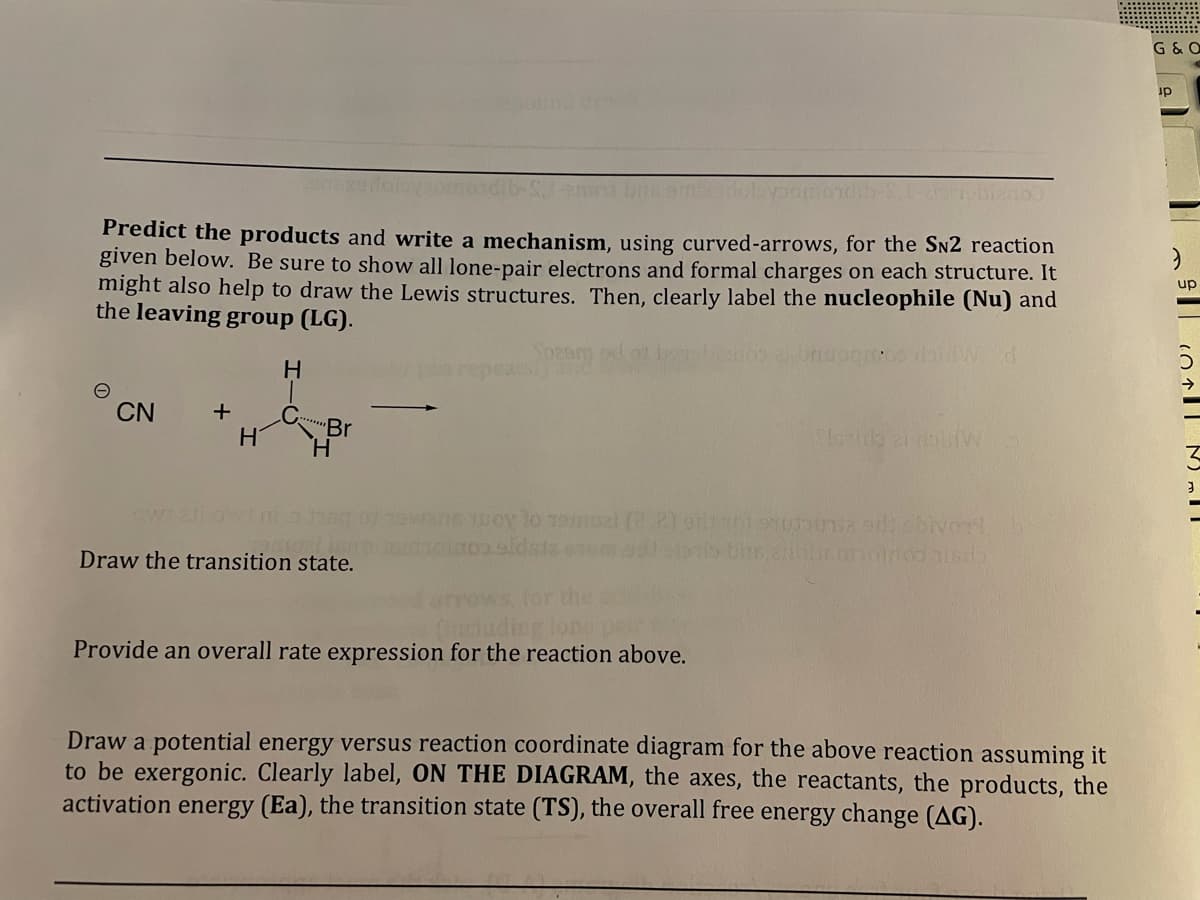Predict the products and write a mechanism, using curved-arrows, for the SN2 reaction given below. Be sure to show all lone-pair electrons and formal charges on each structure. It might also help to draw the Lewis structures. Then, clearly label the nucleophile (Nu) and the leaving group (LG). H CN + Br Draw the transition state. Provide an overall rate expression for the reaction above. Draw a potential energy versus reaction coordinate diagram for the above reaction assuming it to be exergonic. Clearly label, ON THE DIAGRAM, the axes, the reactants, the products, the activation energy (Ea), the transition state (TS), the overall free energy change (AG).
Predict the products and write a mechanism, using curved-arrows, for the SN2 reaction given below. Be sure to show all lone-pair electrons and formal charges on each structure. It might also help to draw the Lewis structures. Then, clearly label the nucleophile (Nu) and the leaving group (LG). H CN + Br Draw the transition state. Provide an overall rate expression for the reaction above. Draw a potential energy versus reaction coordinate diagram for the above reaction assuming it to be exergonic. Clearly label, ON THE DIAGRAM, the axes, the reactants, the products, the activation energy (Ea), the transition state (TS), the overall free energy change (AG).
Organic Chemistry: A Guided Inquiry
2nd Edition
ISBN:9780618974122
Author:Andrei Straumanis
Publisher:Andrei Straumanis
Chapter14: Elimination
Section: Chapter Questions
Problem 22E
Related questions
Question

Transcribed Image Text:up
Predict the products and write a mechanism, using curved-arrows, for the SN2 reaction
given below. Be sure to show all lone-pair electrons and formal charges on each structure. It
might also help to draw the Lewis structures. Then, clearly label the nucleophile (Nu) and
the leaving group (LG).
up
H.
CN
Br
Draw the transition state.
Provide an overall rate expression for the reaction above.
Draw a potential energy versus reaction coordinate diagram for the above reaction assuming it
to be exergonic. Clearly label, ON THE DIAGRAM, the axes, the reactants, the products, the
activation energy (Ea), the transition state (TS), the overall free energy change (AG).
Expert Solution
This question has been solved!
Explore an expertly crafted, step-by-step solution for a thorough understanding of key concepts.
Step by step
Solved in 2 steps with 2 images

Knowledge Booster
Learn more about
Need a deep-dive on the concept behind this application? Look no further. Learn more about this topic, chemistry and related others by exploring similar questions and additional content below.Recommended textbooks for you

Organic Chemistry: A Guided Inquiry
Chemistry
ISBN:
9780618974122
Author:
Andrei Straumanis
Publisher:
Cengage Learning


Organic Chemistry: A Guided Inquiry
Chemistry
ISBN:
9780618974122
Author:
Andrei Straumanis
Publisher:
Cengage Learning
